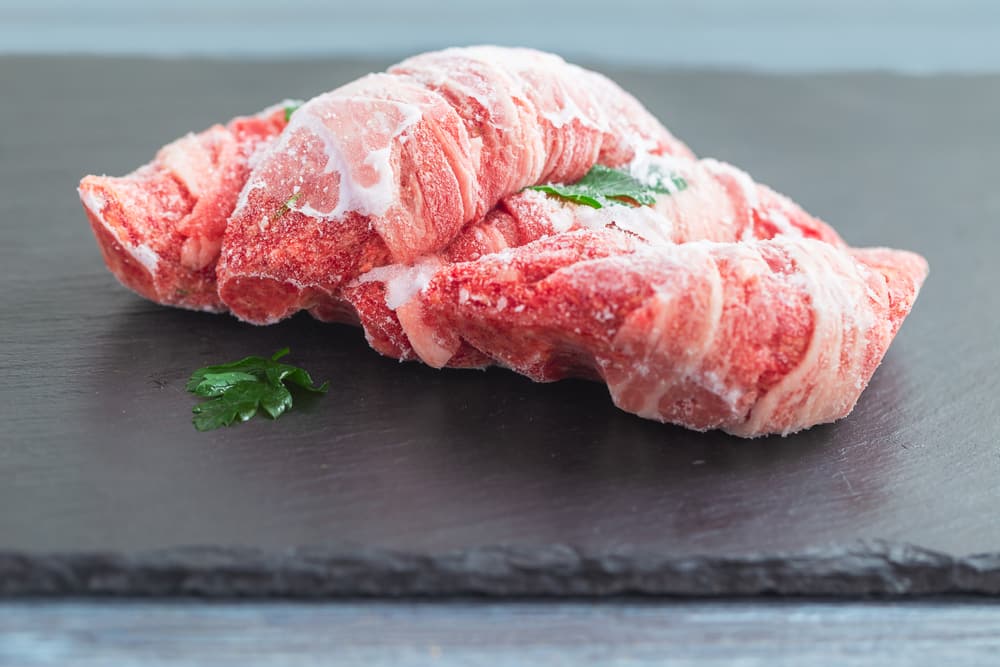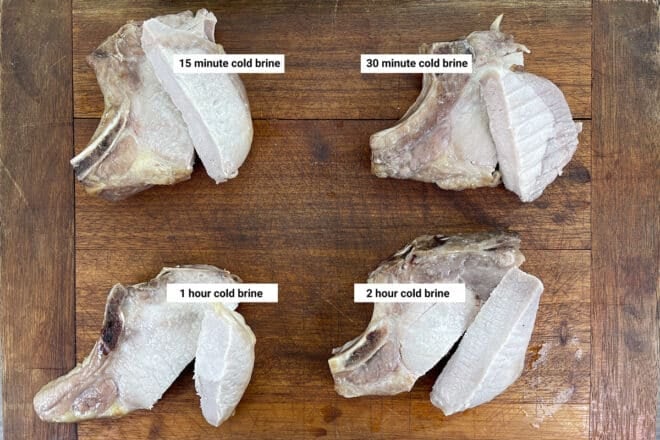I’ve experimented to find out the perfect way and amount of time to brine pork chops. You will love this pork brine recipe and method because the pork always turns out so juicy and tasty.
Sometimes pork chops are dry and flavorless, but there are two things that can make them taste and feel better: (1) Not cooking them too long (pork should be slightly pink in the middle, at about 145°F); and (2) Putting them in a wet brine to add salt, flavor, and moisture. A bunch of tests were done to find the best pork brine mixture and the right amount of time to brine pork chops of different sizes.
If you want to skip straight to the recipe, click here. Below are more details about how to do this.
Brining is the process of soaking meats in a salt water solution before cooking. Why would you need to do that? There’s a few reasons actually.
The meat soaks up the salt water which results in meat with more moisture, even after cooking. The salt also changes the texture of the meat, making it more tender. In addition, that salt is adding seasoning and flavor for a more delicious dish. For more information about brining, head over here.
So, brining is the best way to make a pork chop that is juicy, tender, and full of flavor.
As a home cook who loves experimenting in the kitchen, I’m always looking for ways to make my pork chops juicier and more flavorful. Recently, I started getting curious about brining. Can you brine frozen pork chops? What are the benefits? Are there any downsides I should know about? I decided to dig into the details so I could find out if brining frozen pork chops is worth trying.
After doing some research, I discovered that yes, you absolutely can brine frozen pork chops! However, there are a few things you need to keep in mind to make sure you end up with properly brined chops that are seasoned just right. In this article, I’ll share everything I learned about brining frozen pork chops
Do You Need To Thaw Pork Chops Before Brining?
My first question was whether I’d need to thaw the frozen pork chops before putting them in a brine. According to what I read, it’s very important to thaw pork chops completely before brining.
When the chops are frozen, the brine can’t properly penetrate into the meat This prevents the brine from infusing the pork with flavor. It also causes uneven brining, so some areas end up more seasoned than others.
To avoid poor brining results, I learned you should thaw frozen pork chops in the refrigerator overnight. Or, you can place them on a plate and defrost them in the microwave using the defrost setting. Once thawed, the chops are ready for brining.
How To Brine Thawed Pork Chops
The process of brining thawed pork chops is simple:
-
Make a brine by combining water, salt, sugar, and any other flavorings like herbs and spices. The basic ratio is 1 cup salt to 1 gallon water.
-
Place thawed pork chops in a plastic zip-top bag or a container.
-
Pour the brine over the pork chops until they’re fully submerged.
-
Seal the bag or container and refrigerate. The brining time can range from 30 minutes to 4 hours depending on thickness.
-
Once brined, rinse off chops and pat dry. They’re ready to cook as usual.
The brine infuses the pork with seasoning and moisture, so the chops turn out juicier and pack more flavor compared to unbrined chops.
Pro Tips For Brining Frozen Pork Chops
After learning the basic brining method, I picked up some helpful expert tips to take my brined frozen pork chops to the next level:
-
Customize the brine: Add chopped garlic, rosemary, thyme or other herbs and spices to the brine to infuse more complex flavors. Brown sugar or maple syrup can provide richer sweetness.
-
Brine in advance: You can brine thawed pork chops 1-2 days before cooking. This gives more time for seasoning to permeate the meat. Store brined chops in the fridge.
-
Don’t reuse brine: Always make fresh brine each time. Reusing brine can transfer bacteria to the raw pork.
-
Rinse after brining: Be sure to rinse pork chops and pat dry after removing from brine. This removes excess salt from the exterior.
-
Cook properly: Brined chops cook a bit faster. Adjust cook times slightly to avoid overcooking.
Frequently Asked Questions About Brining Frozen Pork Chops
As I researched brining frozen pork chops, there were a few common questions that came up. Here are some quick answers:
Can you brine partially frozen pork chops?
It’s not recommended. Thaw them completely first to allow even brining and flavor distribution.
Is it OK to brine for longer than the recipe states?
It’s easy to over brine. Stick to recommended times based on thickness to avoid overly salty results.
Can you brine pork chops in too weak a brine solution?
Yes, the chops may not take on enough seasoning if the brine is diluted. Use proper salt to water ratios.
Do you have to cook brined chops right away?
You can refrigerate brined chops up to 2 days before cooking. Any longer may compromise freshness.
Can I bake or grill brined pork chops?
Absolutely! Brining enhances flavor and juiciness when pan frying, baking, or grilling.
Brined Pork Chops Are Worth The Effort
After getting all the details, I’m excited to try brining frozen pork chops myself. While it does take a bit of planning with the thawing and brining time, it seems well worth it for more delicious, juicy chops. I have a feeling brined pork is going to become one of my go-to easy dinner recipes. The next time I stock up on pork chops, I’ll be sure to pop some extras in the freezer so they’re ready to brine.

How Long For Thin Pork Chops
They look like my favorite pork chops: they have the bone in and are one inch thick. However, I do sometimes buy the thinner cut chops, especially when they’re on sale.
The thinner chops are usually boneless loin chops, although sometimes they do have some bone. These chops are at most 1/2 of an inch thick.
It makes sense that thinner chops did better with less brining time—anywhere from 30 minutes to an hour. Any shorter and they remained tough, any longer and they became too salty.
How Long Should I Brine Pork Chops?

I did the bulk of my testing using those center-cut bone-in pork chops that were 1-inch thick. Please keep in mind that I tested some thinner chops along with the 1-inch thick chops. I’ll talk about those below.
I put the 1-inch pork chops in the salt brine for 15, 30, 1, 2, 4, and 8 hours to see how they would turn out. The 15-minute and 30-minute brined pork chops had a good seasoning on the outside, but they were still tough when they were done cooking. The 4-hour and 8-hour brines were unbearably salty and the meat was overly soft. I don’t recommend that unless you reduce the amount of salt used in the brine.
The best brining times for the one-inch thick chops is therefore between one and two hours. For this long, the chops had just the right amount of seasoning and were soft all the way through, even the middle, which is usually the driest part. And, importantly, it wasn’t so long that the chops got too salty.
